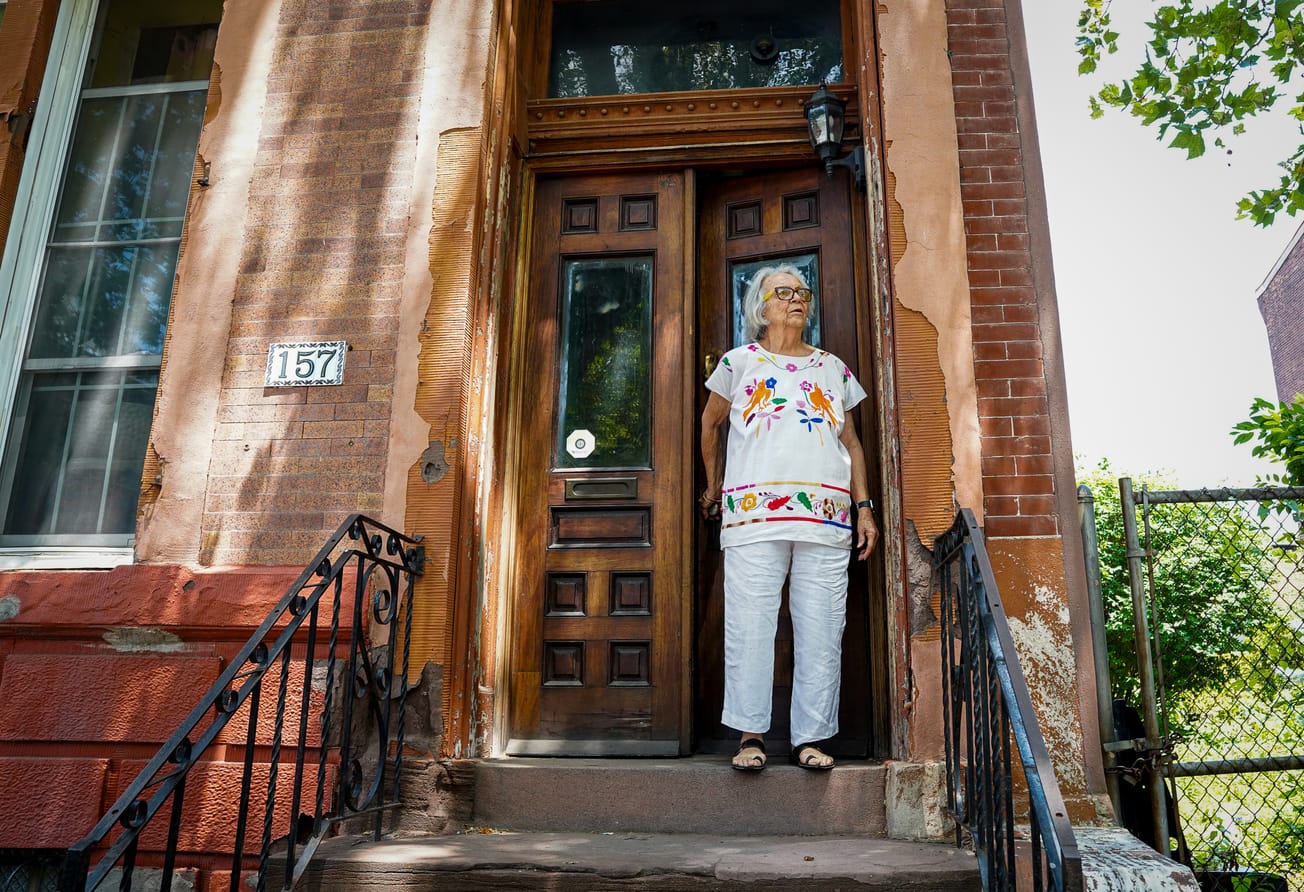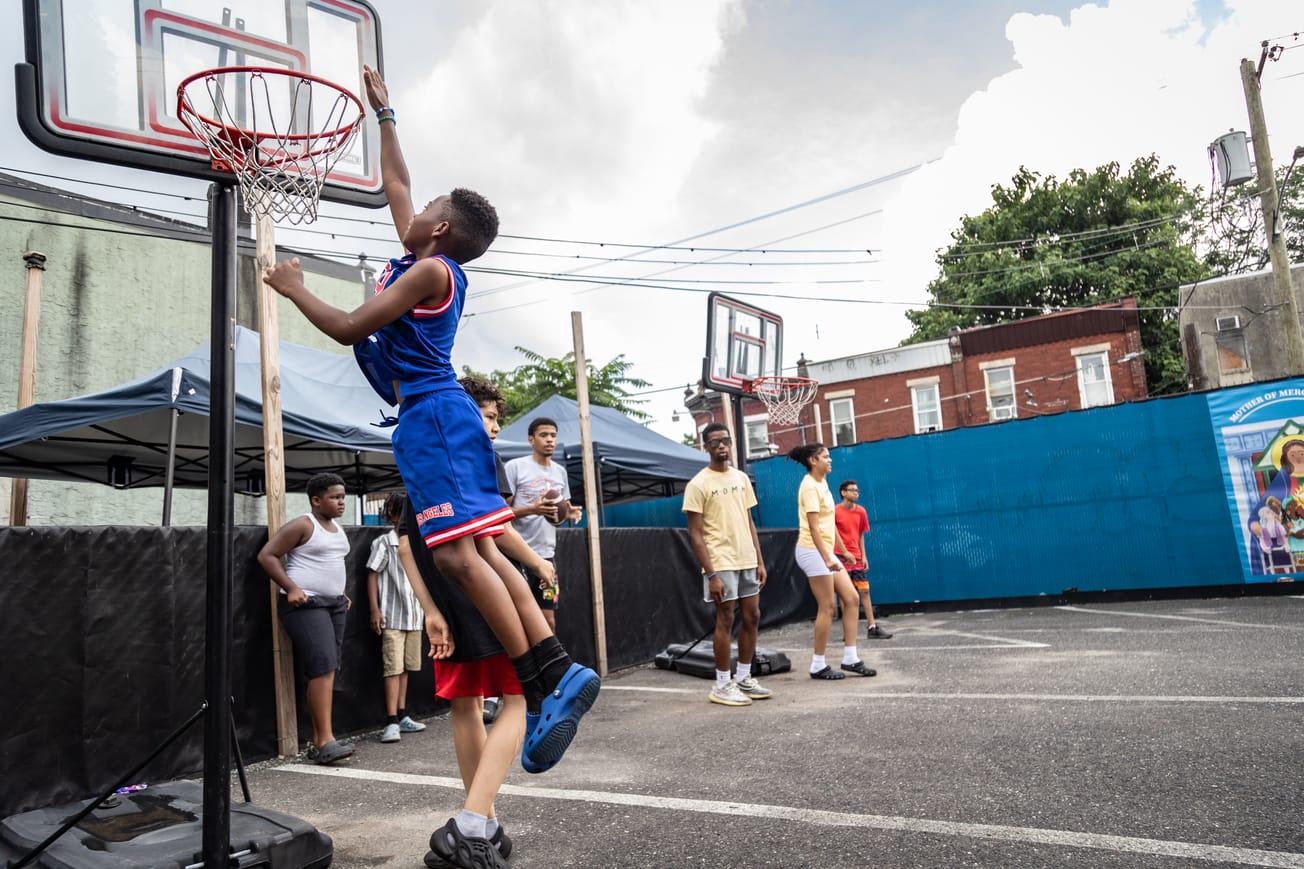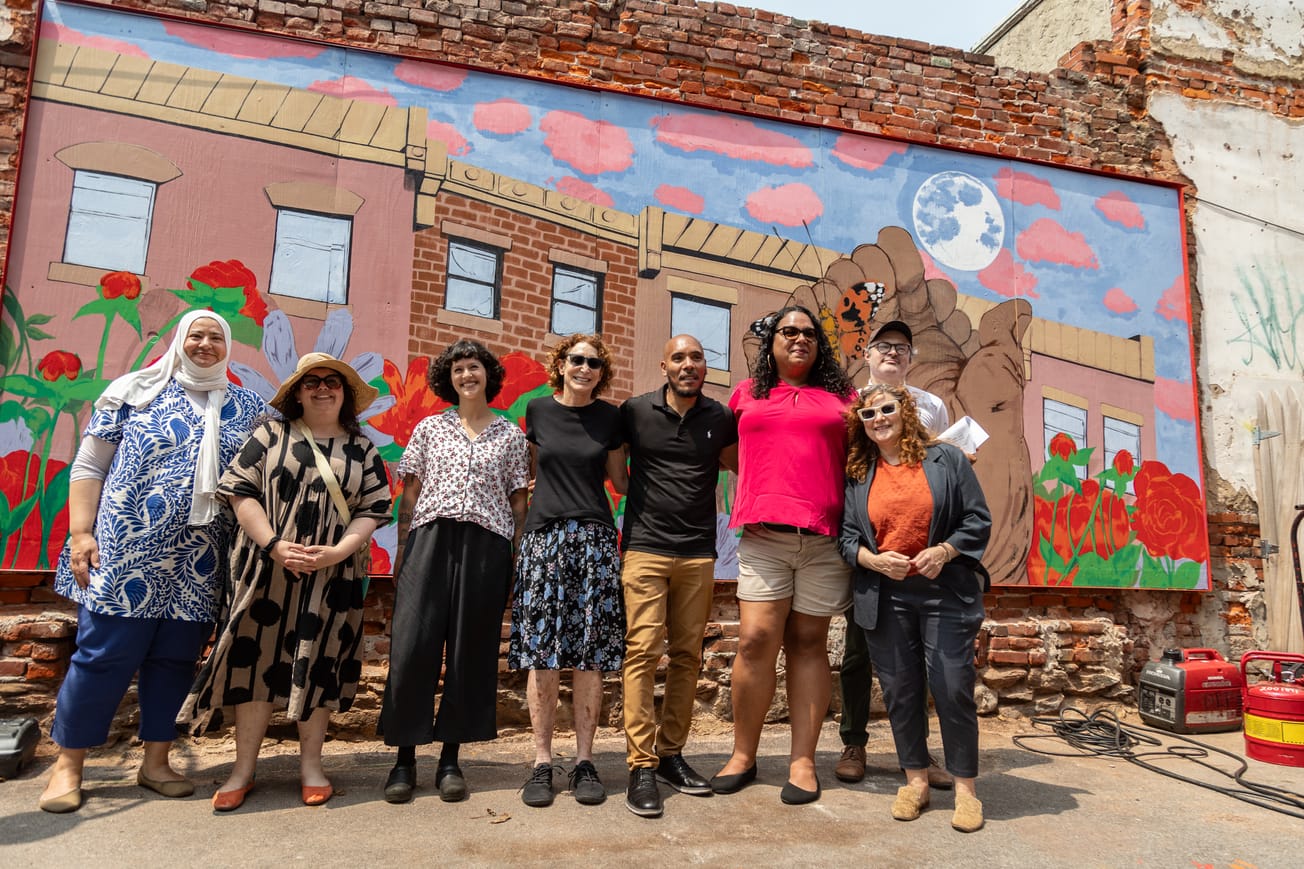Sunflower Hill Park is carved into a valley about 10 feet below the sidewalk on the 1700 block of North 5th Street near Cecil B. Moore Avenue. You probably wouldn’t notice it unless you were looking for it.
The public space is decked out with string lights, charcoal grills, picnic benches, flags from around the world painted on wooden panels — Japan, France, and Brazil, to name a few — two small stages, and a handful of raised garden beds. The park’s namesake is a hill on the north end that flourishes each summer into a cluster of sunflowers that grow taller than most people.
A mural of a plane taking off overlooks the garden — a fitting symbol of the otherworldly energy that commands the space. Paul Cherashore, the co-founder of the Philadelphia Overdose Prevention Initiative (POPI), describes it as “womb-like,” and one that “wraps people in an embrace of beauty.”
Sunflower Hill is what Cherashore envisions a garden in Kensington — maintained by people who use drugs and some who don’t — would look and feel like. He believes it could serve as a source of healing for people in the neighborhood and provide a safe environment to reconnect with the natural world.
But his vision has yet to come to fruition.

In 2017, City Councilwoman Maria Quiñones-Sánchez gave Cherashore permission to create a garden in memory of Paul Yabor, Cherashore’s friend and fellow harm reduction advocate who died of an overdose earlier that year, on a narrow city-owned lot on American Street between Indiana Avenue and Cambria Street. But since POPI started using the space, Cherashore has run into challenges including experiencing language barriers, balancing the needs of the garden with those of the surrounding community, and connecting with nearby organizations.
Additionally, Cherashore discovered that the city is beginning a construction project on the land he is using in June, and he has to clear his plants out by then. He was told he could store his plants and supplies in a lot across the street, but after returning from a winter hiatus, he found that space is now home to a handful of trucks and shipping containers. He said he’s having trouble getting confirmation as to whether he will be allowed to return to the original space when construction finishes, though he is unsure if he desires to do so due to the lack of privacy there and limited space.
Cherashore feels that some of the challenges he has faced are due to a lack of support from various communities for an initiative like this. He believes that resources oriented towards acknowledging these aspects of wellness tend to be reserved for those who society “deems worthy to benefit from those intangible aspects,” which tend to be “non-controversial” ones — a label not typically associated with people who use drugs.
“There’s the whole discussion of good poor vs. bad poor. There’s the good poor who are just victims,” Cherashore said. “Then there’s the other poor — people who use drugs, sex workers, [and] people who are in and out of jail, that are somehow less deserving of our empathy.”

For many, Cherashore’s vision is hard to comprehend. It places drug use and community spaces on the same team — something Cherashore said most people aren’t conditioned to accept.
“People say, ‘Oh well, we don’t want drug users around,’” Cherashore said. “Well, there is drug use. So I think a lot of it is about the fact that people really object certain negatives.”
Not only does Cherashore’s vision toe the line of what is considered socially acceptable, but a public garden won’t be an immediate source of revenue for the community, he explained.
“Gardens won’t bring any economic value in the short run,” Cherashore said. “I mean it does, but it’s more abstract.”

Green spaces as harm reduction
Cherashore isn’t alone in wanting to utilize green spaces as a means of harm reduction — others are already doing it.
Hives for Humanity (HFH) is a nonprofit organization based in Downtown Eastside Vancouver, an area that often garners media attention for its high rates of poverty, homelessness, and addiction. The organization was founded by mother-daughter duo Julia and Sarah Common and offers workshops and services centered around caring for the beehives they have onsite as a means for healing and community building.
“It’s sort of where people who don’t fit get pushed to,” said Sarah Common in a phone interview with Kensington Voice. “Or they come and seek acceptance.”
Sarah said that HFH works to foster connections among different communities, create a place where people feel welcome, and provide safety and resources. In addition to their gardening and beekeeping workshops, they also offer a green space where everyone is accepted. The organization has on-site drop boxes for used needles and provides small stipends to those who help to maintain the grounds.
When asked about policies regarding on-site use of drugs, Sarah said that all they ask at HFH is that “people are being respectful of the gardens, the plants, the bees, the people, and that they aren’t putting themselves or others at risk,” — a request that she said people have largely honored.
The organization is located next to InSite, the first supervised injection site in North America. Sarah said they don’t want to “push people further into isolation,” which is why one of their main concerns about people using drugs on their land is that they don’t use alone because it’s more dangerous.
And according to Sarah, HFH has had an impact. She’s watched one man, in particular, grow since he came to the garden for the first time three years ago.
“He used to avoid all human interaction, and he would sit in front of the beehives just watching them,” she said. “Now he is beekeeping with us, doing workshops, and helping with our honey.”

The science behind green healing spaces
There is a substantial body of scientific evidence vouching for the positive effects of green spaces on community safety and general wellness, according to Peg Schofield, a registered horticultural therapist, and horticulture professor at Temple University’s Ambler campus.
“Green spaces, open spaces, and community gardens help lower crimes,” Schofield said. “It raises morale in folks — it engages people in terms of a community.”
Schofield referenced a pioneer study on the relationship between environment and psychology, conducted in 1993 by Stephen Kaplan and Christopher Peterson. The researchers examined the role that “environmental intangibles” can play in serving as a guide to community planners.
Since Kaplan and Peterson’s study, ample amounts of research have followed supporting the relationship between environment and general wellbeing, such as this one by Andrew Chee Keng Lee, Hannah C. Jordan, and Jason Horsley. The authors of that study concluded that consideration of public health benefits should be a mandatory component of urban planning which would give green spaces an avenue for systematic recognition. But they also acknowledged challenges like other urban planning responsibilities, market forces, and economic considerations.
Despite those challenges, the authors said that consideration of intangible aspects of public health should be valued just as much as more traditional elements of community planning, such as minimization of air, water, and noise pollution, and reduction of greenhouse gas emissions through carbon dioxide absorption.
According to Schofield, creating and maintaining urban green spaces can also increase property value — a nod to the more instant results historically favored in community planning circles. Additionally, she said they contribute to a sense of wholeness.
“If you go down a street that’s lined with trees, well, guess what? The property values are higher,” Schofield said. “There’s a season for everything, and people who are struggling with PTSD, grief, abuse, etc. — understanding the cycles of nature can be a metaphor for their transformation.”
Connecting people to their surrounding environments can serve as a vehicle to help people transition from “hopelessness to hopefulness,” she added.
But despite evidence that shows community gardens increase property value and improve the wellbeing of residents, and successful harm reduction efforts similar to POPI, Cherashore knows there are still personal, political, and social barriers he has to overcome to bring this idea to fruition.
“It’s a different take on the top-down receipt of services from experts that people experience at syringe exchange programs and all other professionalized harm reduction services,” Cherashore said. “But given the twelve steps idea that addiction is a spiritual disease, then where is the place for a spiritual salve, other than organized religion and twelve-step rooms?”
“And that’s what I’m talking about,” he continued. “Not just to have a garden, but something more conscious. A healing space and integration of services.”
Editor: Jillian Bauer-Reese / Designer: Jillian Bauer-Reese / Translator: Kristine Aponte





